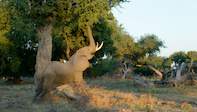
What Do Elephant Eat?
While everyone agrees that elephants eat both grasses and leafy material from shrubs and trees, some debate has been ongoing in scientific circles as to whether elephants prefer to graze or to browse, and what influences their preferences.
Codron collected fresh elephant dung samples throughout the park in both the wet and dry seasons from 2002 to 2004. To get precise measures of the amount of grasses to shrubby material, she subjected dung samples to chemical analysis that looked at the carbon and nitrogen levels in the dung.
By looking at the ratio of the different molecular weight carbon atoms, carbon-13 and carbon-12, the scientists can find out the ratio of woody plants to grasses eaten. This is possible because grasses and broad-leafed plants like trees and shrubs convert carbon dioxide into plant material using two different photosynthetic pathways.
The different photosynthetic methods produce different ratios of carbon-13 to carbon-12 in the plant matter, which is reflected in the dung that passes out of the elephants. By using dung, seasonal changes in diet can also be found in a non-invasive way.
The researchers also collected dung from another mixed feeder, the impala, for comparison, as well as dung from giraffe, kudu, buffalo, wildebeest and zebra to help show what levels of carbon atoms are present in pure grazers and browsers. For the purposes of the investigation, the park was divided into two broad climatic zones, the wetter south and the drier north.
Codron found that the elephants in the north of the park consistently eat more grass than elephants in the south, with northern elephants having a dry season diet of about 40 percent grass, compared to southern elephants eating about 10 percent grass.
They found that this trend is reversed in impalas, where southern impalas eat about 50 percent grass and northern ones about 35 percent grass. Looking at the results across seasons, elephants throughout the park ate more grass during the wet season.
However, the elephants in the south showed much more seasonal variation, switching from mainly browsing (10 percent grass) in the dry season to half browsing and half grazing in summer. During summer the impalas also stepped up their grass intake, with northern impalas now eating 65 percent grass and southern impalas eating 60 percent grass.
The amount of grass elephants in the north eat is interesting in light of the fact that the north of the park is covered in mopane trees while the south has almost none, and mopane trees are reported by other scientists to be a preferred food for elephants.
The authors of the paper discuss previous work carried out on elephants and mopane trees, which has shown that young mopane leaves are favoured by elephants because of their high protein content.
However, mopane trees also produce chemicals that can make the plant taste bad to elephants. Some chemicals produced by mopane trees inhibit the digestive processes of animals, and if eaten in a high enough proportion can be poisonous.
This suggested to the authors that the elephants in the mopane covered north of the park prefer grasses for most of the year in order to avoid eating too much of the potentially toxic mopane leaves and bark.
Codron concludes that the research has shown that elephant dung can be used to rapidly compare elephant diets from different places and times to get an idea of changes in diet, which can help feed into management plans in areas where elephants might be impacting on woody plants.By Melissa Wray

 How Many Teeth Does an Elephant Have? In their lifetime, Elephants work their way through six sets of molars. As one set wears out, another...
How Many Teeth Does an Elephant Have? In their lifetime, Elephants work their way through six sets of molars. As one set wears out, another...